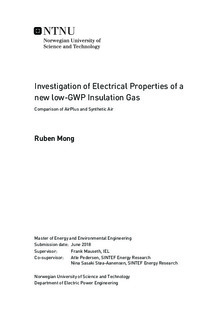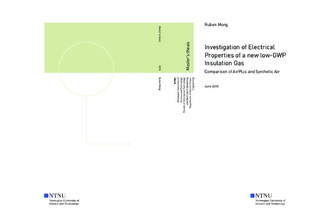| dc.description.abstract | Sulfur hexafluoride (SF6) is a widely used insulation gas in medium- to high-voltage equipment due to its excellent dielectric properties. It has however one important weakness; a large global warming potential (GWP) of 23,900 CO2-equivalents, making it a target for phase out by legislative entities such as the European Union. This report will investigate a new potential low-GWP gas to replace SF6 in medium-voltage equipment called AirPlus, a combination of 7.5% synthetic air and 92.5% C5 Perfluoroketone (C5 PFK).
To test the dielectric performance of AirPlus, the up-and-down method is used with a standard lightning impulse (LI) as voltage stress and 1 minute waiting time between each application. The method provides an estimate for the 50\% breakdown voltage and the standard deviation. AirPlus will be tested for gas pressure, gap length, electrode shape, and polarity. The pressure is chosen to 1.00 and 1.50 bar, and the gap length is adjusted between 10 and 80 mm. The electrode configurations are chosen to represent both inhomogeneous field distribution using a rod-plane gap, and a quasi-homogeneous field distribution using a plane-plane gap. The three rods used in the rod-plane gap have a hemispherical tip of radius 2.5, 5.0 and 10.0 mm.
In homogeneous fields, the results for the plane-plane gap showed negligible impact of LI polarity for both synthetic air and AirPlus. For the three rod-plane gaps, the inhomogeneous field distribution confirmed that synthetic air is most dependent on positive polarity, resulting in higher values for U50% compared with negative polarity. AirPlus on the other hand is most dependent on negative polarity, sharing the same property as SF6, resulting in higher values for U50% compared with positive polarity. The difference between negative polarity and positive polarity in AirPlus is generally 7-10 kV or higher.
The study of inhomogeneity and breakdown voltage revealed that AirPlus could be more sensitive to increased inhomogeneity than synthetic air. The critical flashover voltage is 50% larger for AirPlus compared with synthetic air in homogeneous fields, but for inhomogeneous fields, the measured critical flashover voltage is only 30% larger in AirPlus compared with synthetic air.
Before changing a parameter, each test series was re-tested for the first gap length after performing the up-and-down method for all gap lengths. The re-testing resulted in an average increase of 10.6% for synthetic air and only 1.8% for AirPlus. The low impact of breakdowns is also reflected in the gas analysis of AirPlus which showed no indication of gas decomposition after 94 LI breakdowns at 1.50 bar.
For the scope of this project, AirPlus is an improvement from synthetic air and can be used for more compact protection designs. It is also beneficial that the critical flashover voltage in AirPlus is less affected by breakdowns than synthetic air. An important discovery is the potential reduced dielectric strength for increased field inhomogeneity caused by the shape of the electrodes, reducing the benefit of using AirPlus instead of synthetic air, from 50% to approximately 30%. | |

